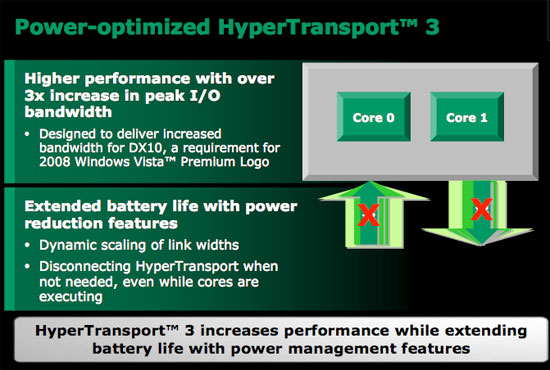AMD's Next-Generation Mobile Architecture Revealed: Griffin
by Anand Lal Shimpi on May 18, 2007 12:10 AM EST- Posted in
- CPUs
Mobile Specific HT3
Much like Phenom, Griffin will support HyperTransport 3, offering more bandwidth between the CPU and the outside world. A major change to Griffin's HT interface however is that it is highly power optimized.

By default, a Griffin CPU has two x16 HT3.0 links (one inbound and one outbound); depending on power and bandwidth requirements, those links can be dynamically scaled down to x8, x4, x2 or completely turned off. The inbound and outbound lanes can dynamically change independent of one another (e.g. inbound could be scaled to x8 while the outbound could be turned off). Each link width change requires a HT disconnect, meaning it can't be done as frequently as a CPU frequency change, but the power savings should be substantial.
Better Thermal Control
Griffin adds better thermal control than its predecessor. The mobile K8 cores simply had a single on-die analog thermal diode that would report CPU temperature, while Griffin features two thermal sensors per core for more accurate thermal monitoring.
The current generation Turion CPUs communicate processor thermal data over the SMBUS, however an external thermal monitoring circuit is used requiring additional board real estate. Griffin supports an integrated SMBUS interface directly to the chipset, so there's no extra chip required.

Griffin also allows monitoring of DRAM temperature (through an external temperature sensor placed near the DRAM modules) and based on pre-configured thermal limits, it can now throttle memory frequency if the modules get too hot.










36 Comments
View All Comments
mesyn191 - Friday, May 18, 2007 - link
For the mobile space a cheap power efficient platform (not just a CPU but a NB/SB, wireless chipset, graphics, driver support, etc...) is far more important than sheer CPU performance.Griffin sure won't beat C2D on performance IPC or clockspeed wise but it will provide them with a viable low cost set of one size fits all tech. that they can sell to the OEM's and that is where the major volume (and thus money) is.
Haltech - Friday, May 18, 2007 - link
Unleess AMD thinks they can add Barcelona to the mobile market Intel will continue to add market share in mobile front. Plus it seems like their implying ATI graphics only when talking about discrete graphics.One question- why 6 sata ports and 14 usb ports...
tygrus - Sunday, May 20, 2007 - link
Using desktop chipset becomes a problem of overkill, wasting silicon and power. Need to be slimmed down but that would still be more expensive due to smaller production.
How much power do they use when inactive ?
strikeback03 - Tuesday, May 22, 2007 - link
Are there any desktop chipsets that support 14 USB ports? I don't remember seeing any.JarredWalton - Friday, May 18, 2007 - link
There are plenty of notebook users that want decent performance with LOOOONG battery life. If AMD can provide better typical battery use, they could still make some waves. At present, Turion X2 is already competitive with C2D in low power states, but at load they fall behind. A few optimizations could help them in both areas.Lonyo - Friday, May 18, 2007 - link
But that won't really help them in a years time.Competing in 12 months with what Intel has today means than when Intel has moved on 12 months, they will likely be ahead again, so overall nothing will have changed, although the consumer will reap the benefits :)